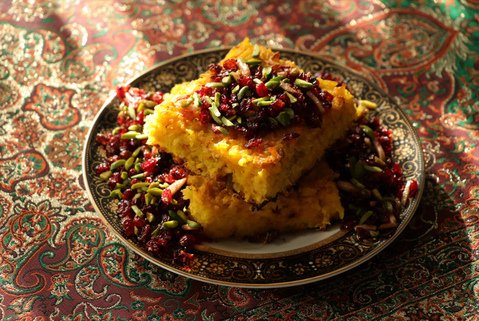Ğuf: The Traditional Turkish Dessert That Deserves the Spotlight
Introduction
Whether you realize it or not, you may have already encountered the sweet, rich flavors of Ğuf—a beloved Turkish dessert with deep cultural roots and a comforting homemade charm. Made from a semolina-based dough and filled with ingredients like walnuts, dried fruit, and even chocolate, Ğuf is more than just a dessert—it’s a heritage passed down through generations.
But what exactly is Ğuf, and why is it steadily becoming a favorite among dessert lovers around the globe? In this article, we’ll explore the fascinating world of Ğuf, from its ingredients and regional variations to its health benefits and tips for making it at home.
So buckle up—you’re about to discover why this humble Turkish sweet deserves a place on your table.
Overview of Ingredients & Preparation
At its core, Ğuf is a baked or boiled sweet that uses a few simple, staple ingredients:
-
Semolina flour
-
Yogurt or milk
-
Butter or olive oil
-
Eggs
-
Sugar or honey
-
Chopped walnuts or other nuts
These ingredients come together to form a dough, which is either rolled into balls or spread in a dish. Traditionally, it is boiled or baked until golden brown. The finishing touches may include a drizzle of syrup or a dusting of cinnamon and nuts, depending on the region or family recipe.
Modern variations also include flavorings like vanilla, orange zest, or even a hint of rosewater, making it an adaptable dessert for many tastes.
Variety of Serving Options
One of the most delightful things about Ğuf is how versatile it is. Though delicious on its own, it can also be served in a wide variety of ways:
-
With Syrup or Honey: The classic Turkish serving method—soaked in a warm, spiced sugar syrup or drizzled with floral honey.
-
With Ice Cream: A modern take includes pairing warm ğuf with a scoop of creamy vanilla or pistachio ice cream.
-
Layered as a Parfait: Alternate layers of ğuf with yogurt, dried fruit, and nuts for a healthy and photogenic treat.
-
Dipped in Chocolate: For a more indulgent experience, ğuf can be coated in dark chocolate and chilled for a rich, satisfying dessert.
-
Savory Brunch Twist: While not traditional, some chefs experiment with less sugar and use ğuf in savory dishes—an innovative spin!
Health Benefits of Ğuf
Despite being a dessert, Ğuf offers a surprising number of nutritional perks—especially when made with natural ingredients and less processed sugar.
High in Vitamin B and Magnesium
Walnuts and semolina are great sources of Vitamin B, essential for energy and brain function. Magnesium, found in nuts and whole grains, supports heart health and muscle function.
Low in Saturated Fats
Using olive oil or yogurt in place of butter can make ğuf a lighter option than many Western pastries.
Full of Antioxidants
The walnuts used in Ğuf are packed with antioxidants that may help reduce inflammation and support immune health.
Naturally Sweetened Options
Using dried fruits like dates, figs, or apricots not only enhances flavor but also adds natural sugars and fiber, making it a smarter choice for sweet cravings.
Finding Ğuf in Turkey & Abroad
In Turkey
Ğuf is commonly found in Turkish bakeries (pastane) and family-owned cafés. It’s particularly popular in coastal and central regions like Izmir and Afyon, where variations can include local nuts, fruits, and spices.
Regional Varieties
-
Izmir-style Ğuf: Often contains citrus zest and cardamom.
-
Eastern Anatolia versions: May be made with molasses or pomegranate syrup.
-
Istanbul interpretations: Include a more polished presentation, often served with a dollop of clotted cream (kaymak).
Abroad
As Turkish cuisine continues to grow in global popularity, many Mediterranean restaurants and Turkish pastry shops around the world now include ğuf in their dessert menus. Additionally, diaspora communities have brought family recipes to countries like Germany, the Netherlands, and the U.S.
Making Your Own Ğuf at Home
Base Ingredients
-
2 cups semolina flour
-
1 cup yogurt or milk
-
1/2 cup butter or olive oil
-
2 eggs
-
1/2 cup sugar or honey
-
1/2 cup chopped walnuts or almonds
-
1 tsp baking powder
-
Optional: vanilla extract, orange zest, cinnamon
Instructions
-
Preheat oven to 350°F (175°C).
-
Mix wet ingredients in one bowl and dry in another.
-
Combine both mixtures, stirring until a thick dough forms.
-
Shape into small balls or spread into a greased baking dish.
-
Bake for 20–25 minutes until golden brown.
-
Cool slightly, then drizzle with syrup or sprinkle with nuts.
Tips for Making a Perfect Ğuf
Ingredients
Use high-quality ingredients. Fresh eggs and natural yogurt will give your ğuf a richer, fresher flavor. Avoid overly processed sugars or artificial syrups.
Equipment
-
Mixing bowls
-
Whisk or electric mixer
-
Baking dish or steamer
-
Spatula and measuring cups
Technique
-
Cream butter and sugar well before adding eggs.
-
Don’t overmix the batter after adding flour—this keeps it soft.
-
Allow to cool before adding toppings to prevent sogginess.
Conclusion
From humble origins in Turkish kitchens to its rising presence in global cuisine, Ğuf is more than just a dessert—it’s a celebration of tradition, family, and flavor. With its simple ingredients, countless variations, and health-friendly benefits, Ğuf is a delicious reminder that the best dishes often come from the heart.
So next time you’re in the mood for something sweet, skip the store-bought cookies and try whipping up your own batch of ğuf. Whether you enjoy it warm from the oven or dressed up with gourmet toppings, you’re bound to fall in love with this Turkish treasure.
Afiyet olsun! (Bon Appétit!)







![Swimsuit Edition [Abbb] - 1.20 21 Swimsuit Edition - Chapter](https://www.geniussclick.com/wp-content/uploads/2025/07/rsz_swimsuit_edition_abbb_-_120_21_swimsuit_edition_-_chapter-300x199.jpg)





Post Comment